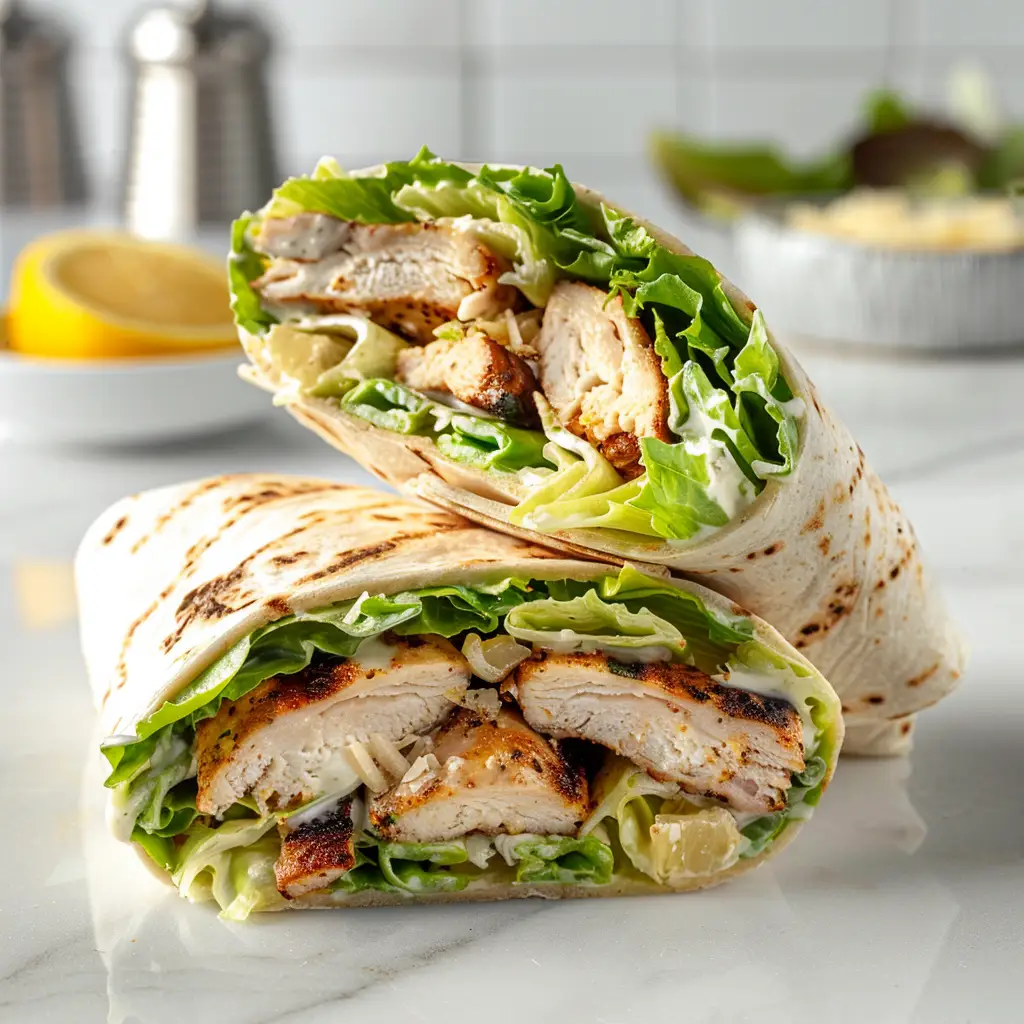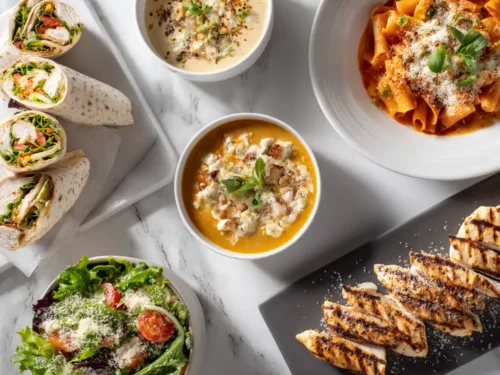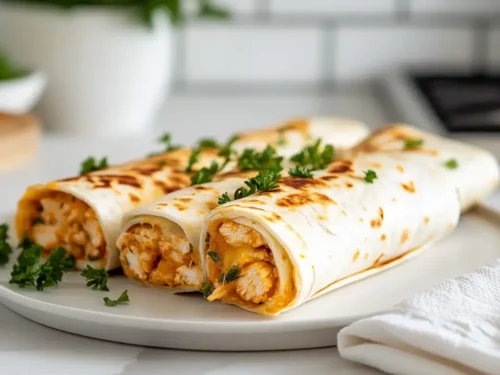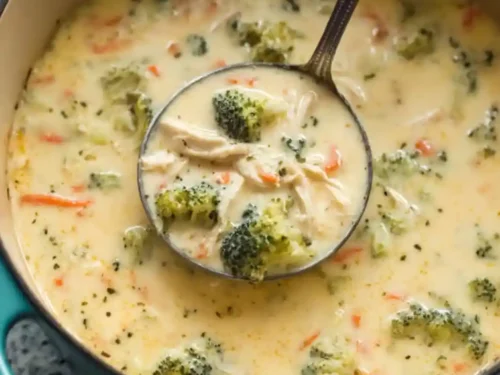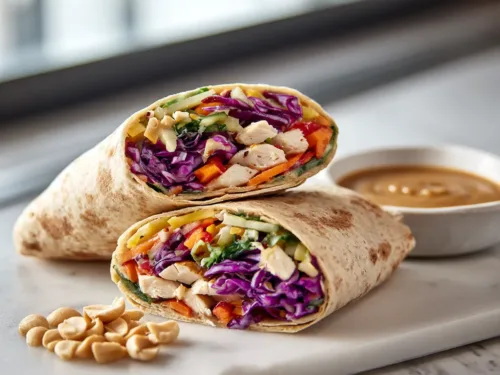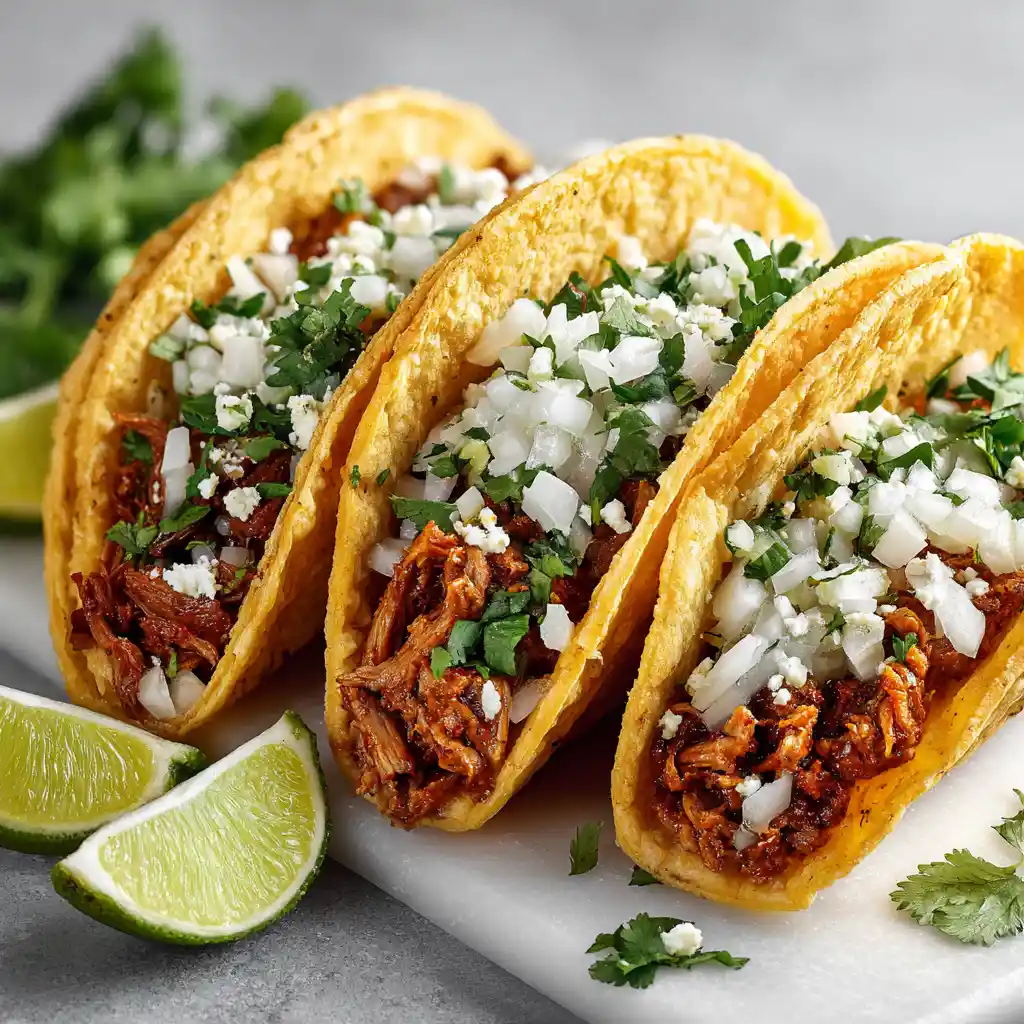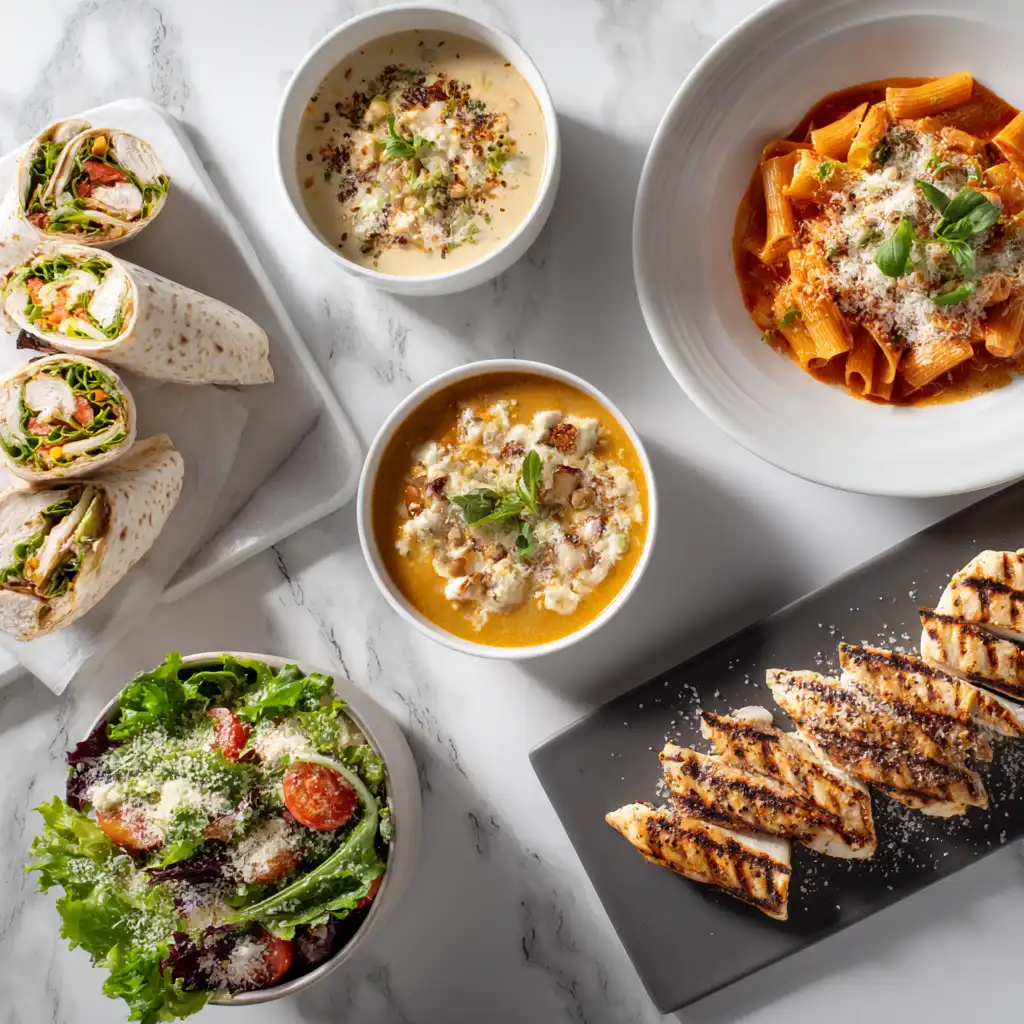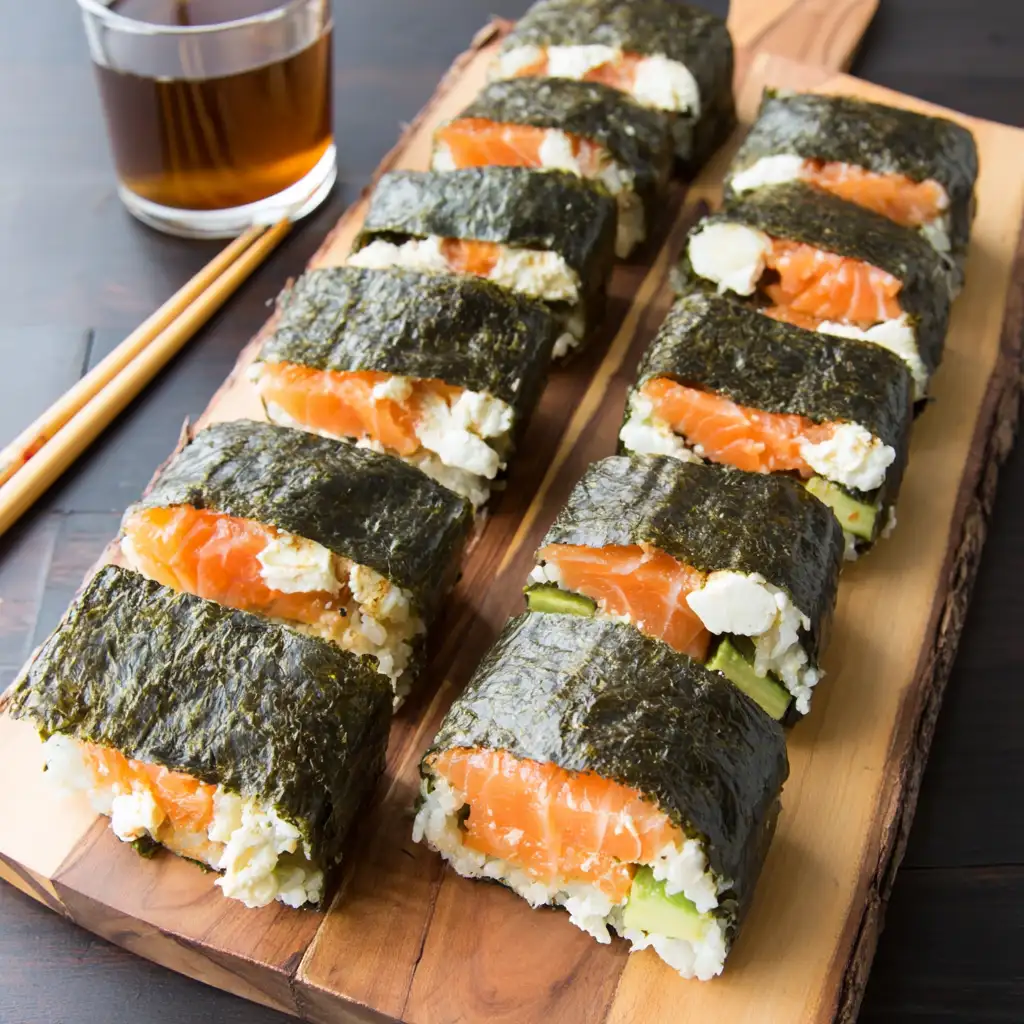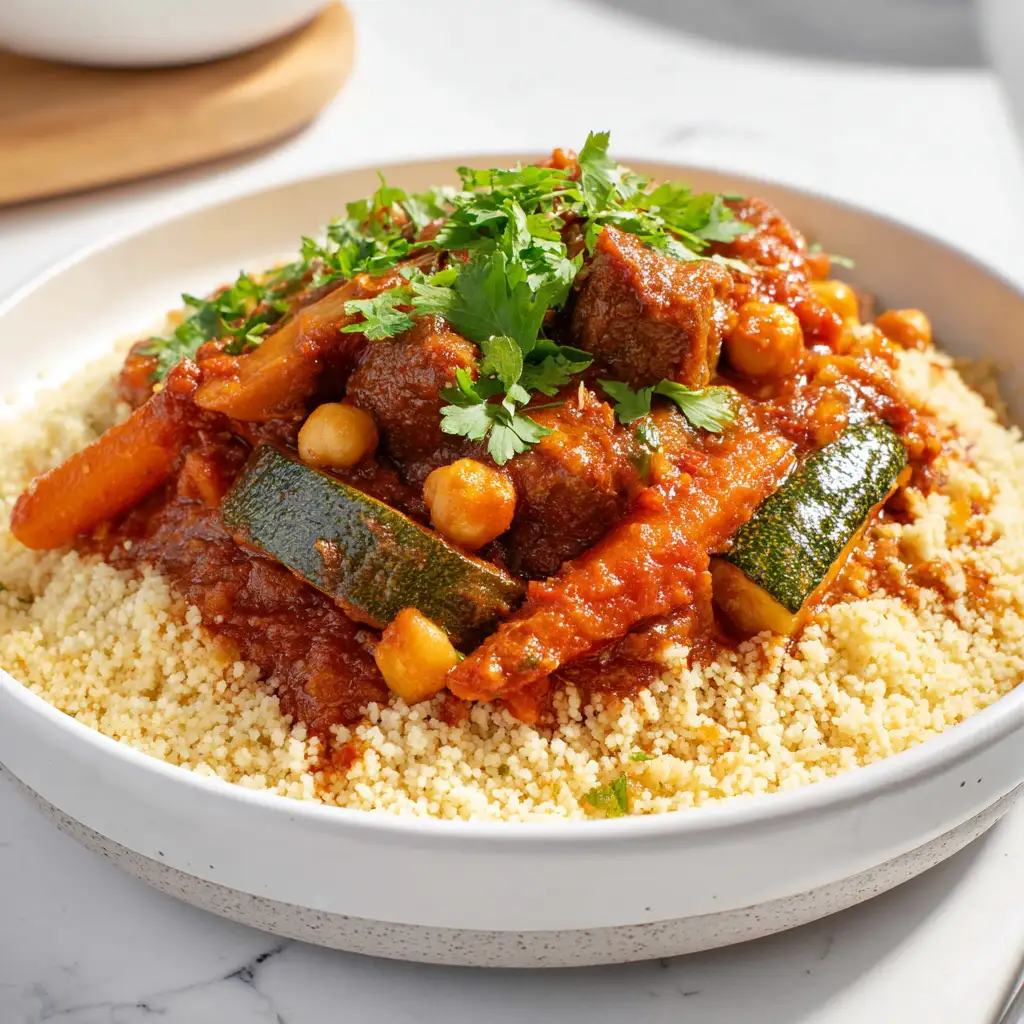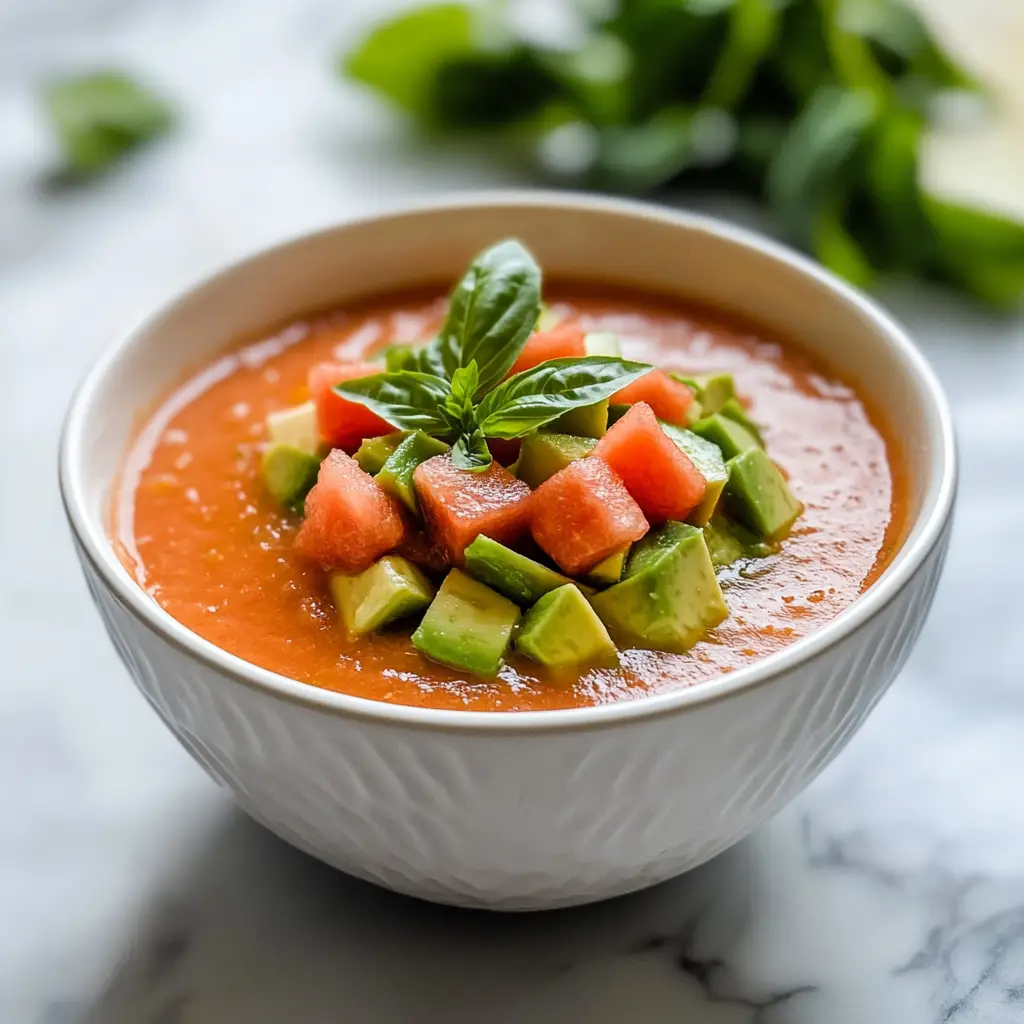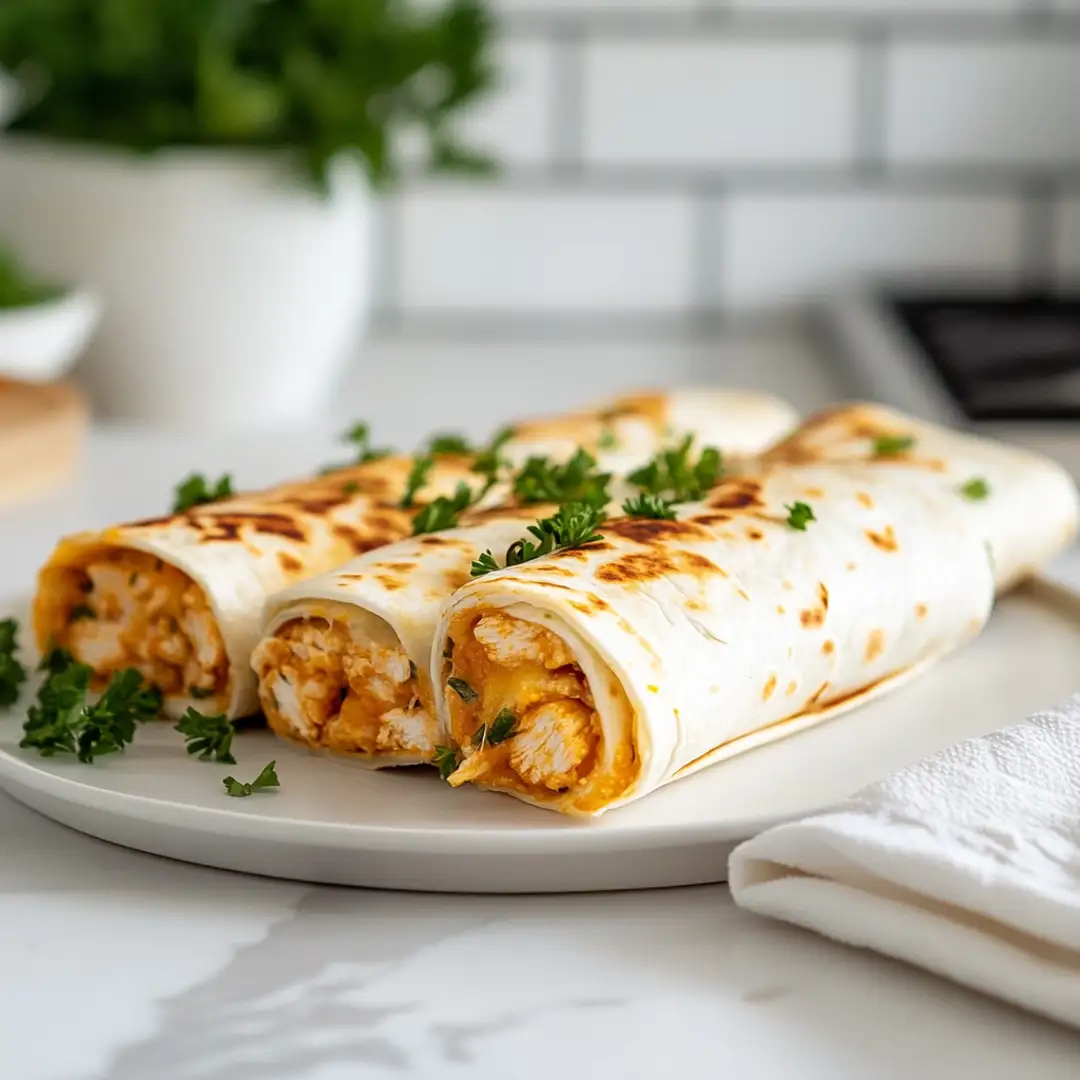Nora here! Last Tuesday afternoon, I’m standing in the McAlister’s Deli line. Starving. Like, haven’t-eaten-since-breakfast level of starving.
I’m staring at their menu, and this Grilled Chicken Caesar Wrap is calling my name. It looks perfect – creamy Caesar dressing, crispy romaine, and grilled chicken, all wrapped up nice and neat in a tortilla. My mouth is literally watering.
But then my brain does that annoying thing: “Wait, how many calories is this?”
So I pull out my phone and start googling. Big mistake.
One website says 370 calories. Another says 640. A third one claims 850. For the SAME wrap.
I’m standing there like an idiot, holding up the line, trying to figure out if I’m about to eat a reasonable lunch or blow half my daily calories on one meal.
You know what I did? I ordered it anyway. Because hunger won.
But when I got home that evening, I went down the deepest rabbit hole. I looked up nutrition databases, compared restaurant menus, made different versions in our kitchen, and basically became obsessed with figuring this out.
What did I discover? Changed everything about how I look at these wraps.
Here’s what you’re getting in this guide:
- The real calorie range (spoiler alert: it’s all over the place)
- Why the same wrap can be 370 calories OR 850 calories
- Restaurant chain comparisons with actual numbers
- Complete nutrition breakdown (protein, fat, sodium – all of it)
- How I make a 343-calorie version at home that Nicolas actually loves
- Smart ingredient swaps that save hundreds of calories
- Whether these wraps are actually healthy (my honest opinion)
Let me walk you through everything so you never have to stand confused in that lunch line like I did.

Healthy Grilled Chicken Caesar Wrap
Equipment
- Skillet
- Meat Thermometer
Ingredients
Wrap Ingredients
- 1 low-carb high-fiber tortilla 80 calories
- 4 oz grilled chicken breast thinly sliced
- 1 cup romaine lettuce chopped
- 2 tbsp light Caesar dressing
- 1 tbsp Parmesan cheese grated
- 1 lemon wedge
- black pepper freshly cracked
Instructions
- Season chicken with salt, pepper, and garlic powder. Grill for 6-7 minutes per side until internal temperature is 165°F.
- Let chicken rest 5 minutes, then slice thinly.
- Warm tortilla in a dry skillet for 30 seconds per side.
- Spread dressing down the center of tortilla. Layer lettuce, chicken, and Parmesan. Add black pepper and a squeeze of lemon juice.
- Roll up the wrap, fold in sides, and slice diagonally.
Notes
Why the Calorie Count Is All Over the Place
Okay, let me just cut through all the confusion right now.
A grilled chicken Caesar wrap can range from 370 calories to 1,100 calories.
That’s not a typo. One thousand one hundred.
That’s more calories than a Big Mac (563 calories). More than two slices of pepperoni pizza. More than… well, you get the idea.
Quick Meal Calorie Table
Type your items below. Enter kcal/serv or enter Protein / Carbs / Fat (kcal auto=4/4/9). US-friendly placeholders (oz, cup, tbsp).
| Item | Serving (note) | kcal/serv | Servings | Protein (g) | Carbs (g) | Fat (g) | kcal | |
|---|---|---|---|---|---|---|---|---|
| Totals | 0 | 0 | 0 | 0 | 0 | |||
Disclaimer: This tool is a simple estimate for general use in US-style recipes. Nutrition values vary by brand, restaurant, and preparation. Not medical or dietary advice.
Here’s the Basic Range:
Homemade (if you’re careful): 340-510 calories
Fast casual restaurants: 370-640 calories
Full-service restaurants: 750-1,100 calories
According to the USDA FoodData Central, a standard homemade grilled chicken Caesar wrap with typical ingredients contains approximately 450-500 calories.
But – and this is a big but – that assumes normal portions. Which restaurants definitely don’t do.
What Happened When I Made These at Home
Two weeks ago, I did an experiment. I made these wraps three different ways to see how much the calories could actually vary.
Test 1 – My “Careful” Version: Light dressing, small tortilla, measured everything. Result: 380 calories.
Test 2 – “Restaurant Style”: Generous dressing, big tortilla, extra cheese. Result: 720 calories.
Test 3 – Nicolas Made It: He… used a LOT of dressing. Like, a concerning amount. Result: 890 calories.
Same basic ingredients. Same chicken. But the calories nearly tripled depending on how it was assembled.
Nicolas jumping in: In my defense, I like dressing. A lot of dressing. The wrap was delicious.
Nora back: The point is, the calorie count isn’t some fixed number. It changes dramatically based on five main factors:
The 5 Things That Change Everything
1. Tortilla Size
This alone can add or subtract 200+ calories.
- Small 8-inch tortilla: 140 calories
- Standard 10-inch: 210 calories
- Large burrito-size: 340 calories
2. Caesar Dressing Amount
This is where most people completely lose track.
- Light coating (2 tablespoons): 150-180 calories
- Normal restaurant amount (4 tablespoons): 300-360 calories
- Heavy hand (6 tablespoons): 450-540 calories
3. Chicken Portion
Restaurants vary wildly on this.
- Light (3 oz): 120 calories
- Standard (4 oz): 165 calories
- Generous (6-8 oz): 250-330 calories
4. Cheese Quantity
Parmesan adds up faster than you think.
- Light sprinkle (1 tablespoon): 20 calories
- Normal amount (¼ cup): 80-100 calories
- Extra cheese: 150+ calories
5. The Hidden Extras
This is stuff nobody talks about:
- Butter or oil brushed on tortilla: 50-100 calories
- Croutons: 60-100 calories
- Extra spread or mayo: 50-100 calories
- Grilling oil: 40-60 calories
Add all those “extras” together and you’ve just added 200-360 calories without even realizing it.
My biggest takeaway? After making these at home multiple times, I learned that the difference between a 400-calorie wrap and an 800-calorie wrap usually comes down to two things: dressing amount and tortilla size. That’s it. Those two ingredients can literally double your calorie count.
Restaurant Comparison Guide (The Good, Bad, and Shocking)
Since most people grab these on the go, I spent way too much time looking up nutrition facts for every chain I could find. Here’s what the numbers actually look like:
The Surprisingly Good Ones
Burger King Caesar Chicken Wrap (Grilled)
- Calories: 370
- Protein: 29 g
- Carbs: 36 g
- Fat: 12 g
- Sodium: 980 mg
My take: This was honestly surprising. Burger King doesn’t usually get credit for healthy options, but this one is actually pretty reasonable. Under 400 calories with nearly 30 g of protein? Not bad at all.
Chick-fil-A Cool Wrap (not technically Caesar, but comparable)
- Calories: 350
- Protein: 43 g
- Carbs: 30 g
- Fat: 13 g
- Sodium: 1,360 mg
My take: The protein content here is impressive – 43 grams! This is probably the best fast-food option if you’re watching calories but need protein. The sodium is a bit high but manageable.
The Middle Ground
Chicken Out Rotisserie Grilled Chicken Caesar Wrap.
- Calories: 386
- Protein: 24 g
- Carbs: 31 g (32% of calories)
- Fat: 18 g (42% of calories)
My take: Pretty balanced. Nothing crazy in any direction. This would be a solid lunch choice.
Greens & Grains Grilled Chicken Caesar Wrap.
- Calories: 570
- Protein: 29 g
- Carbs: 61 g
- Fat: 25 g
My take: We’re getting into the higher calorie range here. Those carbs are pretty high – probably means they’re using a large tortilla. Still reasonable if this is your main meal, but not exactly “light.”
The “Wait, What?” Category
Grab a fresh grilled chicken Caesar Wrap.
- Calories: 640
- Protein: 27 g
- Carbs: 52 g
- Fat: 37 g
My take: That fat content is concerning. 37 grams is a lot – that’s mainly coming from excessive dressing. You could save 200+ calories by asking for dressing on the side.
Ranch One Grilled Chicken Caesar Wrap
- Calories: 750
- Protein: 35 g
- Carbs: 58 g
- Fat: 42 g
My take: We’re now in “full meal” territory. This is getting close to what some people eat for dinner.
The One That Shocked Me
McAlister’s Deli Grilled Chicken Caesar Wrap
- Calories: 850
- Protein: 43 g
- Carbs: 56 g
- Fat: 51 g
- Sodium: 2,100 mg
When I first saw these numbers, I literally said “WHAT” out loud in my kitchen.
850 calories. Fifty-one grams of fat. And here’s the kicker – 2,100 mg of sodium. That’s basically your entire daily sodium allowance in ONE wrap.
Nicolas here: Yeah, this used to be my regular lunch order. Twice a week, sometimes more. I’d get the full wrap plus chips. Then Nora showed me these numbers, and I was like… oh. That explains why I wasn’t losing weight.
Nora back: The McAlister’s half wrap is only 410 calories, which is way more reasonable. If you love their wraps, just get the half.
According to Healthline, the average woman needs about 2,000 calories per day, while men need around 2,500. An 850-calorie wrap takes up 43% of a woman’s daily calories in one meal. That’s almost half your day in one wrap.
Complete Nutrition Breakdown (What’s Actually in There)
Let me break down what you’re actually getting in a standard homemade version – the kind you’d make at home with reasonable portions.
Average Homemade Grilled Chicken Caesar Wrap
Calories: 450-500
Protein: 32-38 g
Carbohydrates: 35-42 g
Fat: 18-24 g
Fiber: 3-5 g
Sodium: 800-1,200 mg
Cholesterol: 85-115 mg
Let’s Talk About Each Macro
Protein (32-38 g) – This is Actually Great
This is one of the best things about these wraps. According to the FDA, adults should aim for about 50 g of protein daily on a 2,000-calorie diet.
One wrap gives you over 60% of your daily protein needs. That’s impressive.
Grilled chicken breast is pure lean protein – virtually no carbs, minimal fat, just muscle-building protein that keeps you full for hours. This is why I actually like these wraps for lunch – the protein keeps me from snacking all afternoon.
Carbohydrates (35-42 g) – Mostly from the tortilla
The tortilla contributes 30-35 g of those carbs. Romaine lettuce adds almost nothing – less than 2 g.
If you’re watching carbs, the tortilla is what you need to address. Switch to a low-carb wrap, and you drop the carbs to around 10-15 g total.
Fat (18-24 g) – Context Matters
This might look high, but let’s break it down:
- Caesar dressing: 12-16 g (mostly from olive oil)
- Parmesan cheese: 3-5 g
- Small amount from chicken: 3-4 g
Most of the fat is monounsaturated and polyunsaturated (the “good” fats from olive oil). The saturated fat from cheese is around 4-6 g, which is reasonable.
Fat isn’t the enemy – it helps you absorb vitamins and keeps you full. The problem is when you get into the 40-50 g range, like some restaurant versions.
Sodium (800-1,200 mg) – This is the Real Concern
Here’s where I started paying attention. The American Heart Association recommends no more than 2,300 mg of sodium per day, ideally around 1,500 mg.
A homemade wrap contains about half your daily limit. Restaurant versions are way worse – some pack over 2,000 mg.
Where’s all that sodium hiding?
- Caesar dressing: 300-400 mg
- Parmesan cheese: 200-300 mg
- Pre-seasoned chicken: 200-300 mg
- Tortilla: 200-350 mg
Real talk from me: When Nicolas started watching his blood pressure (it runs in his family), we had to start actually paying attention to sodium. These wraps can be problematic if you’re getting them from restaurants regularly.
What Makes These Wraps So High in Calories?
Let me break down exactly where those calories come from, because once you understand this, everything makes sense.
The Caesar Dressing Problem
Traditional Caesar dressing is basically liquid calories because it’s made with:
- Mayonnaise or egg yolks (pure fat)
- Olive oil (120 calories per tablespoon)
- Parmesan cheese (fat plus protein)
- Sometimes heavy cream (even more fat)
Two tablespoons – which is actually a pretty light coating – contains 150-180 calories and 16-20 g of fat.
But here’s what I discovered: Most restaurants don’t use two tablespoons. They use four, five, or sometimes six tablespoons because it makes the wrap taste amazing and keeps customers coming back.
Four tablespoons of Caesar dressing = 300-360 calories. Just from dressing.
Nicolas’s confession: I used to think wraps were automatically healthier than burgers. Then Nora showed me that some wraps have MORE calories than a Big Mac purely because of the dressing. My mind was blown.
Tortilla Size Is More Important Than You Think
I never paid attention to tortilla size until I actually started measuring the calorie differences.
Check this out:
- Small 8-inch tortilla: 140 calories
- Standard 10-inch: 170-220 calories
- Large 12-inch burrito-size: 290-350 calories
That’s a 210-calorie difference just from tortilla size. That’s equivalent to eating an entire extra snack.
Most restaurants use the big tortillas because they look more impressive, they can fit more filling, and bigger portions feel like better value to customers.
The Cheese Factor
Parmesan is flavorful, so a little goes a long way. But it’s easy to go overboard.
- One tablespoon: 20 calories
- Quarter cup: 100 calories
- Half cup: 200 calories
The difference between “light sprinkle” and “generous amount” is 80-180 extra calories. And you barely even notice you’re adding that much.
Hidden Calories in Restaurant Preparation
This is the sneaky stuff that restaurants do that adds calories without you realizing:
- Brushing tortilla with butter before grilling: 50-100 calories
- Adding mayo or spread to help ingredients stick: 50-100 calories
- Using pre-marinated chicken (contains oil and sometimes sugar): 40-80 calories
- Including extras like croutons: 60-100 calories
- Grilling with oil: 40-60 calories
All these “invisible” additions can add 200-350 calories without appearing on the menu description.
My Lower-Calorie Version (343 Calories and Actually Delicious)
After all this research, I created a lighter version that still tastes really good. Nicolas actually prefers this version now because it doesn’t make him feel heavy afterward.
Nora’s Lighter Grilled Chicken Caesar Wrap
Ingredients:
- 1 low-carb, high-fiber tortilla (80 calories)
- 4 oz grilled chicken breast, thinly sliced (165 calories)
- 1 cup chopped romaine lettuce (8 calories)
- 2 tablespoons light Caesar dressing (70 calories)
- 1 tablespoon grated Parmesan cheese (20 calories)
- Freshly cracked black pepper
- Lemon wedge
Total: 343 calories
Protein: 36 g
Carbs: 22 g
Fat: 12 g
How I Actually Make It
Step 1 – The Chicken
Season chicken breast with salt, pepper, and garlic powder on both sides. Heat a grill pan or cast iron skillet over medium-high heat.
Grill for 6-7 minutes per side until the internal temperature hits 165°F. I use a meat thermometer now after… let’s just say there was an incident where I gave Nicolas food poisoning by undercooking chicken. Not my finest moment.
Let the chicken rest for 5 minutes after cooking. This is crucial – if you cut into it immediately, all the juices run out and your chicken ends up dry.
Slice thin – about ¼ inch slices. Thin slices distribute better in the wrap.
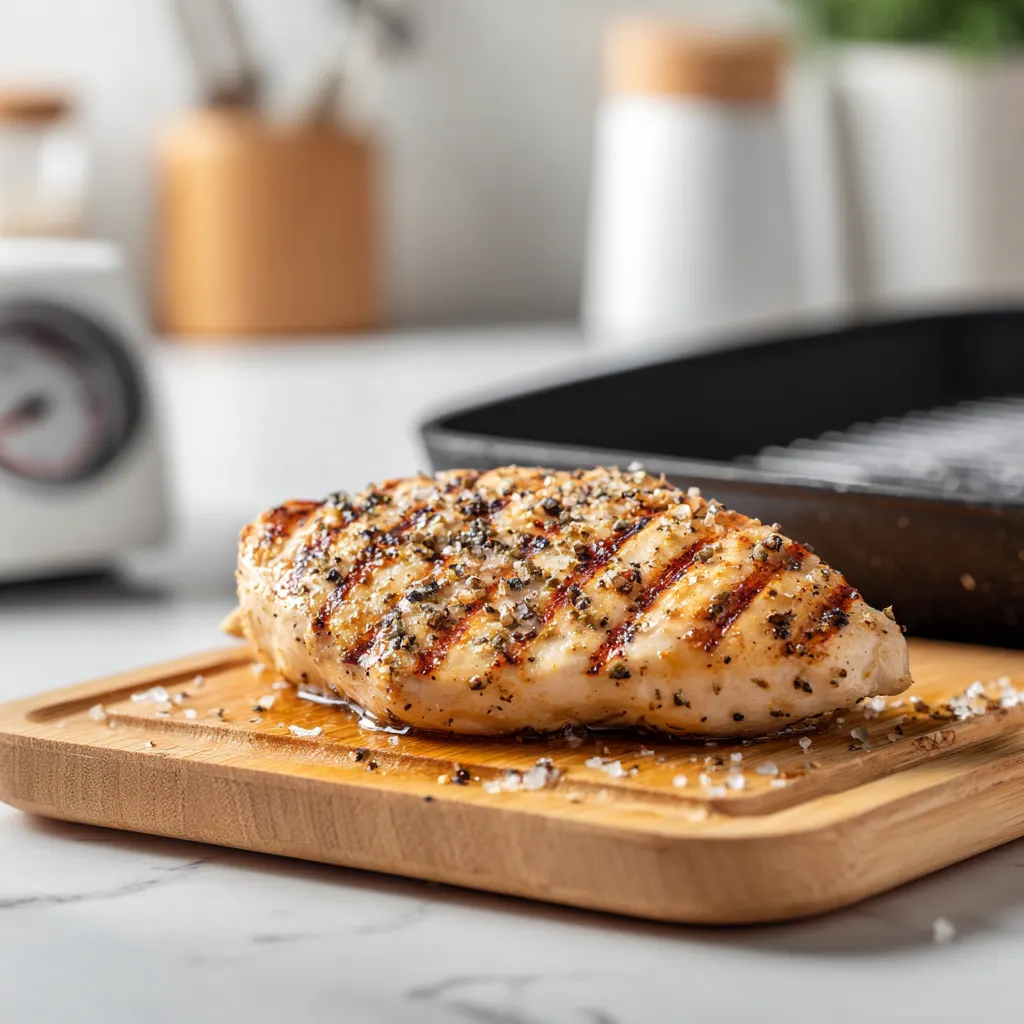
Step 2 – Prep the Tortilla
Warm your tortilla in a dry skillet for 30 seconds per side. This makes it pliable and adds a nice toasted flavor. Cold tortillas crack when you try to roll them.
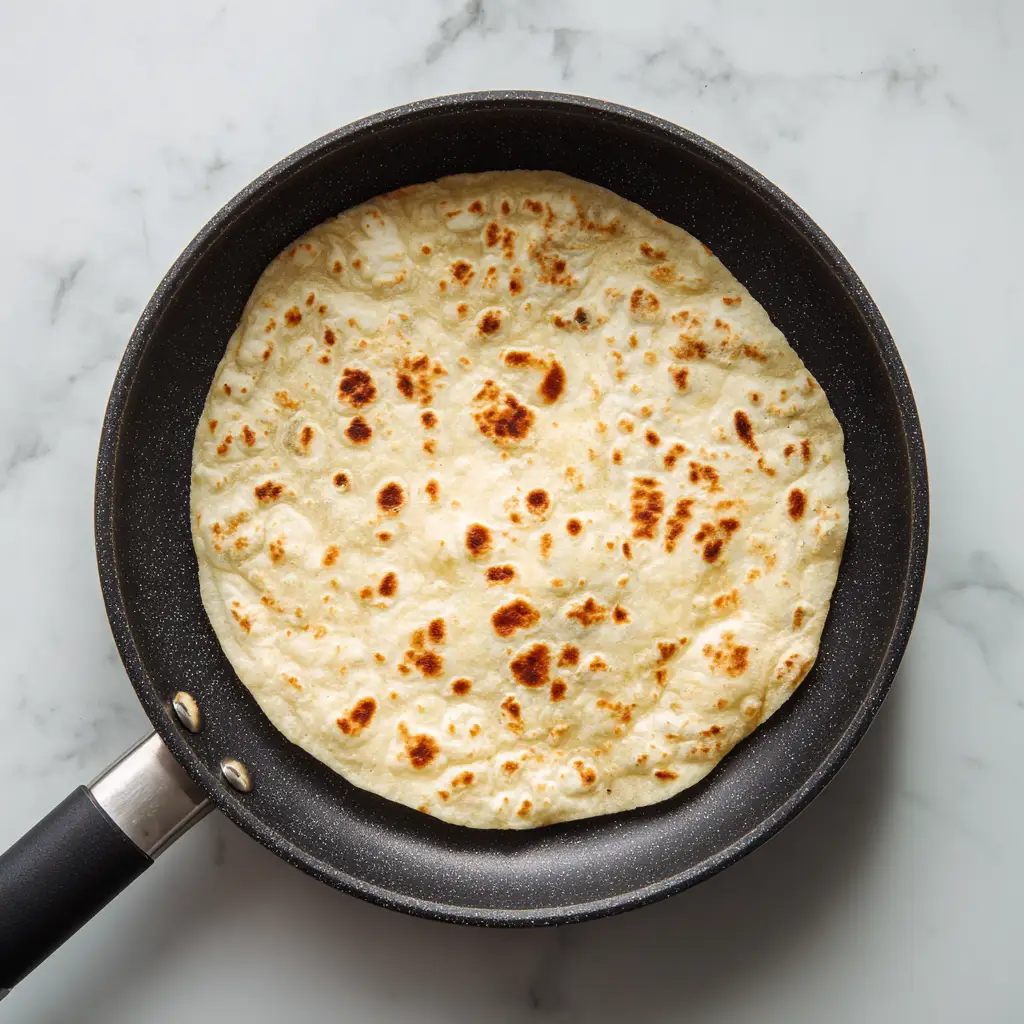
Step 3 – Assembly
Lay the tortilla flat on your work surface. Spread the Caesar dressing down the center, leaving about 2 inches on each side empty.
Layer the romaine lettuce first, then the sliced chicken. Sprinkle Parmesan over everything. Add fresh cracked black pepper. Squeeze a little fresh lemon juice over the top – this brightens everything up.
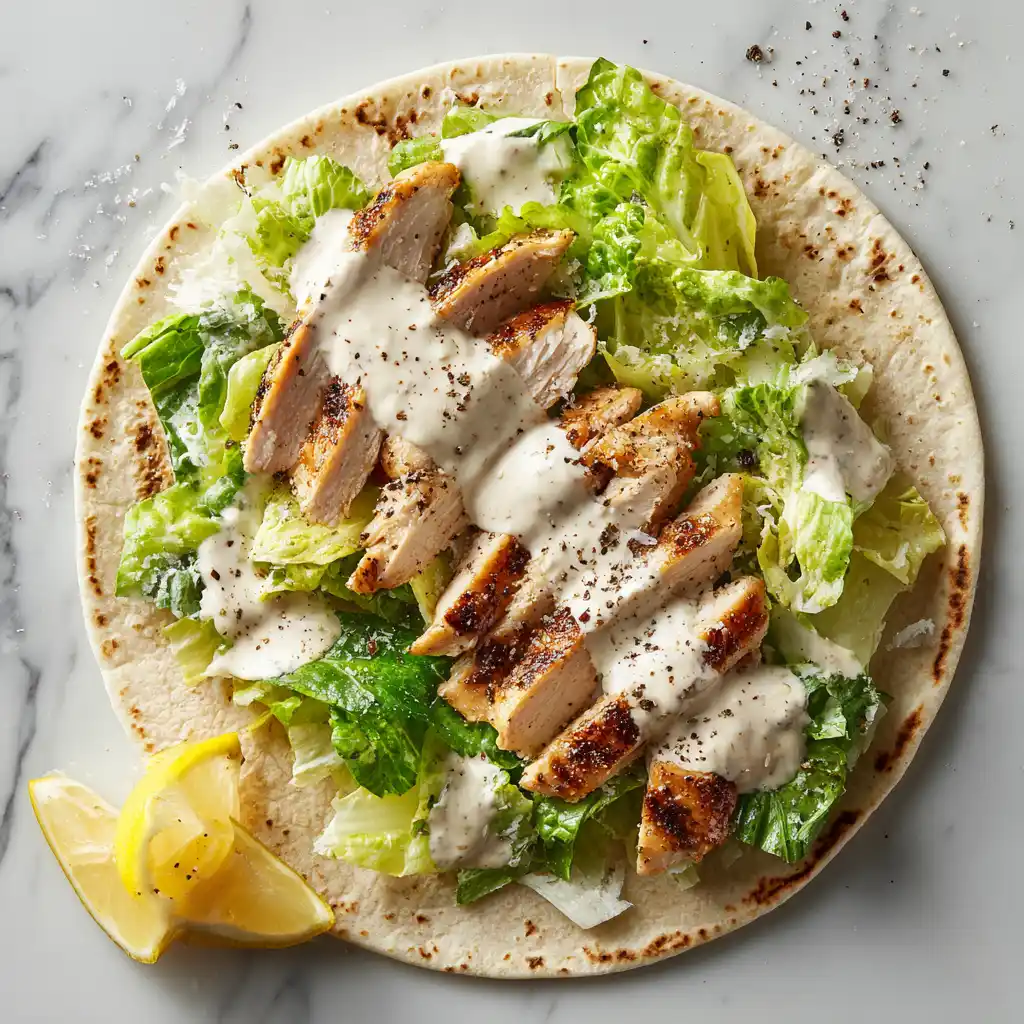
Step 4 – The Roll
Fold in the left and right sides about an inch each. Then, starting from the bottom (where all your fillings are), roll upward tightly but not too tight. You want it snug but not squished.
Cut diagonally across the middle. I don’t know why, but diagonal cuts just make it look better.
The Game-Changer Ingredient
That low-carb tortilla saves about 140 calories compared to a regular burrito-size tortilla. I use Mission Carb Balance wraps. They’re 80 calories, high in fiber, and honestly? You can’t tell the difference in taste.
Nicolas thought I was being crazy when I first bought them. Then he tried one, and now he asks me to buy them every time.
Want the full photo tutorial? I’ve got the complete step-by-step recipe on our site: Grilled Chicken Caesar Wraps Recipe
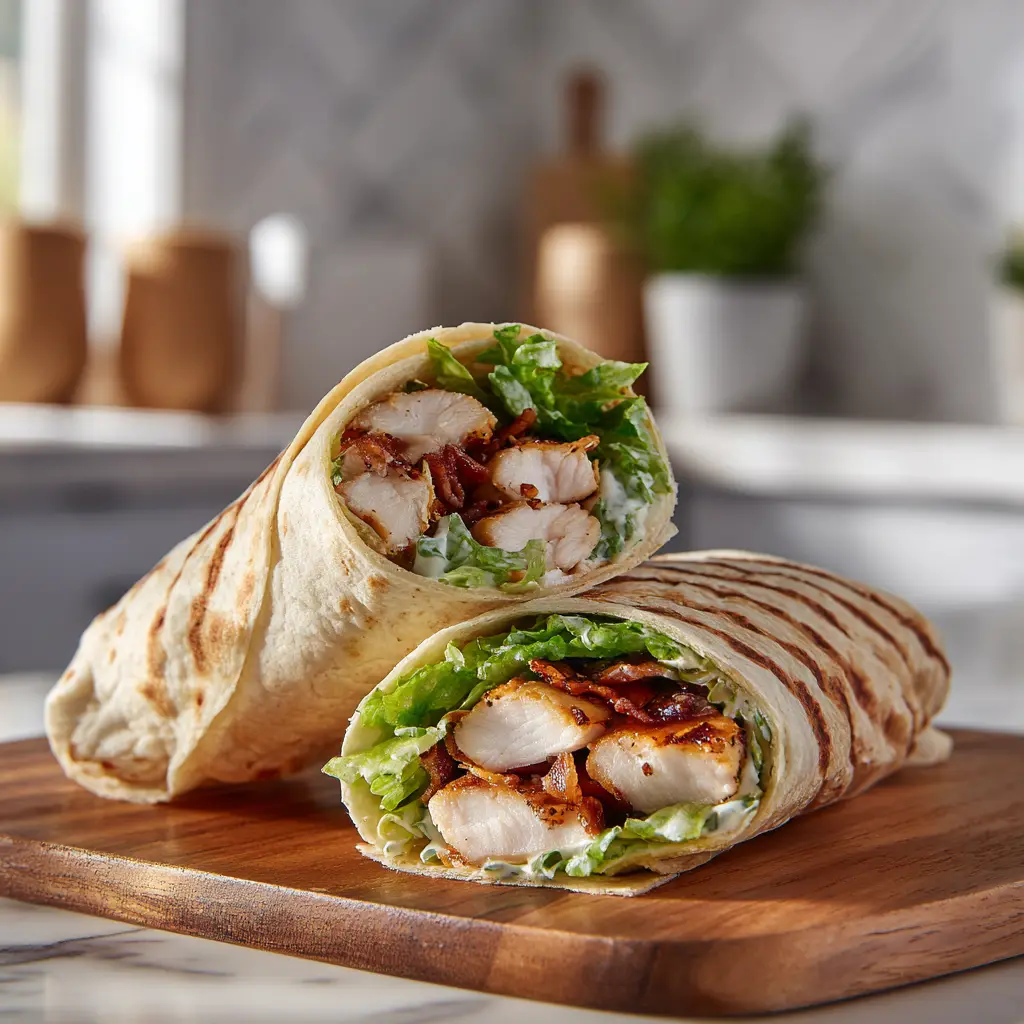
Are Grilled Chicken Caesar Wraps Actually Healthy?
This is the question everyone really wants answered, right?
The honest answer? It depends entirely on how they’re made.
The Good News
High in Protein
With 30-40 g of protein per wrap, you’re getting excellent lean protein that:
- Keeps you full for 3-4 hours
- Supports muscle maintenance
- Helps stabilize blood sugar levels
- Provides all essential amino acids
Contains Vegetables
Okay, romaine lettuce isn’t exactly a superfood, but it does offer:
- Vitamins A and K
- Folate
- Small amounts of fiber
- Hydration (lettuce is 95% water)
Can Absolutely Fit Into a Balanced Diet
At 400-500 calories for a homemade version, this can be part of a healthy eating plan. It’s not “diet food,” but it’s not junk either.
The Concerns
Sodium is the biggest issue.
This is what actually worries me the most. Restaurant versions with 1,500-2,100 mg of sodium in one meal can:
- Raise blood pressure over time
- Cause water retention and bloating
- Put stress on your kidneys
- Increase cardiovascular disease risk long-term
Calorie-Dense Dressing
The fat in Caesar dressing isn’t inherently bad (it’s mostly from olive oil), but it’s incredibly easy to consume 300-400 calories of dressing without realizing it.
Limited Vegetable Variety
Lettuce is fine, but you’re missing out on different nutrients, colors, and fiber sources. You’re basically getting one vegetable when you could be getting five.
Restaurant Versions Can Be Problematic
Wraps with 850+ calories, 50+ grams of fat, and 2,000 mg of sodium aren’t healthy choices for regular consumption. They’re occasional treats, not everyday food.
My Honest Verdict
Homemade, portion-controlled version: Healthy choice
Restaurant versions under 500 calories: Reasonable choice
Restaurant versions: 700+ calories occasional treat only
My personal take: I make these at home regularly because I control what goes in them. We probably have them once a week for lunch, and they fit perfectly into our eating plan.
But when I’m eating out? I either split a restaurant wrap with Nicolas, or I order something else entirely, because those 850-calorie versions just aren’t worth it to me.
Want more ideas for healthy, protein-packed chicken meals? Check out our complete guide to chicken recipes, where we share over 20 family-tested meals that actually taste good.
Simple Swaps That Save Hundreds of Calories
These aren’t theoretical swaps. These are changes I actually use in my kitchen that make a massive difference.
Swap #1: Smaller or Low-Carb Tortilla
Instead of: 12-inch flour tortilla (350 calories)
Use: 10-inch low-carb wrap (80 calories)
You save 270 calories
This is probably the single biggest calorie saver. The low-carb wraps I use (Mission Carb Balance) are 80 calories, super high in fiber, and taste exactly the same to me now.
Swap #2: Greek Yogurt-Based Caesar Dressing
Instead of: 4 tablespoons regular Caesar (300 calories)
Use: 2 tablespoons Greek yogurt Caesar (70 calories)
You save 230 calories
Quick homemade recipe I use:
- 2 tablespoons plain Greek yogurt
- 1 tablespoon grated Parmesan
- 1 teaspoon Dijon mustard
- 1 small garlic clove, minced
- 1 teaspoon fresh lemon juice
- Salt and pepper to taste
Mix everything together. Takes 2 minutes. It’s creamy, tangy, and has way fewer calories than traditional Caesar.
Swap #3: Load Up on Extra Vegetables
Instead of: Just lettuce
Add: Cherry tomatoes, cucumber slices, shredded carrots, bell pepper strips
Calories saved: None, but you get way more volume and fiber, so you feel fuller on fewer total calories.
Swap #4: Use Less Cheese
Instead of: ¼ cup Parmesan (100 calories)
Use: 1 tablespoon Parmesan (20 calories)
You save 80 calories
Honestly? With flavorful dressing and well-seasoned chicken, you barely notice the cheese reduction. The Parmesan is more about adding a salty punch than actual cheese taste.
Swap #5: Try Lettuce Wraps
Instead of: Any tortilla (140-350 calories)
Use: Large romaine or butter lettuce leaves (5 calories)
You save 135-345 calories
Nicolas here: I started doing lettuce wraps when I was cutting carbs a few months ago. Nora thought I was nuts. But honestly? You get all the Caesar and chicken flavor without feeling bloated afterward. Plus I can eat two and still be under 400 calories total.
If You Make All These Swaps
- Low-carb wrap: -270 calories
- Light dressing: -230 calories
- Less cheese: -80 calories
Total savings: 580 calories
That’s the difference between an 850-calorie restaurant wrap and a 270-calorie homemade version that’s still completely satisfying.
Common Questions People Ask Me
850 calories for the full wrap. The half wrap is 410 calories, which is way more reasonable. The full wrap also has 51 g of fat and 2,100 mg of sodium – basically your entire day’s worth of sodium in one meal.
It can be, but only if you control portions and ingredients. A homemade version at 400-500 calories fits into most weight loss plans. Restaurant versions at 700-850 calories will make weight loss really difficult unless it’s literally your only large meal of the day.
Most contain 30-40 g of protein, which is excellent. This high protein content is why these wraps keep you full for so long and are actually good for maintaining muscle during weight loss
Ask for:
Or just order the half portion if the restaurant offers it
Dressing on the side (use only half of what they give you)
No extra cheese or croutons
Extra vegetables if they offer them
Grilled chicken (not crispy/fried)
Whole wheat wrap if available
Not really, unfortunately. The problem is that wraps get soggy when dressing sits on lettuce for hours. Better approach: prep all the components separately (grilled chicken in one container, chopped lettuce in another, dressing in small containers) and assemble fresh each day. Everything stays crisp that way.
Not with a regular tortilla – that’s 30-40 g of carbs right there. But if you use a low-carb wrap (5-10 g carbs) or do a lettuce wrap instead and skip any croutons, they can absolutely fit into keto. The focus becomes the protein and healthy fats from the dressing.
A Caesar salad typically has 200-400 calories depending on how much dressing you use. The wrap version adds 140-350 calories from the tortilla. So wraps have significantly more calories than the salad version, mainly from that tortilla.
The salad is lower in calories and carbs. The wrap is more portable and filling. If you’re watching calories, go with the salad. If you need something portable or more substantial, the wrap works better.
Want another delicious Caesar option? Try our Ultimate Chicken Caesar Salad Recipe for a lighter version with all the same amazing flavors.
Final Thoughts – Making This Work for YOU
Nora here, wrapping this all up.
After spending weeks researching nutrition databases, testing different versions in our kitchen, and comparing restaurant options, here’s what I really want you to understand:
The calorie count in these wraps isn’t fixed. It ranges from 350 calories to over 850 calories depending on who’s making it and how. That’s a 500-calorie swing – literally the difference between a light lunch and half your daily calories.
Understanding where those calories come from gives you the power to make better choices.
You don’t have to give up food you enjoy. I’m never going to be the person who tells you to stop eating grilled chicken Caesar wraps if you love them. Life’s too short to eat food you don’t like.
But I am going to tell you that making them at home with lighter ingredients and being smart about portions can cut the calories in half while keeping all the flavor.
Restaurant versions aren’t evil – you just need to know what you’re getting. If you know the McAlister’s wrap is 850 calories, you can make an informed decision. Maybe you get the half. Maybe you skip the side and save those calories. Maybe you know you’re eating lighter at dinner to balance it out.
Knowledge is power.
Nicolas’s final thought: These wraps were my default lunch order for years because I genuinely thought I was being healthy. Once Nora showed me the actual numbers, I was shocked. But instead of giving them up completely, we figured out how to make better versions at home. Now I can eat them guilt-free, and they actually help me hit my protein goals. Problem solved.
Your Action Plan
If you’re eating these at restaurants:
- Check the nutrition information before ordering.
- Consider ordering half portions.
- Always ask for dressing on the side.
- Skip the extras you don’t really need.
If you’re making them at home:
- Start with my 343-calorie recipe as your base.
- Try the Greek yogurt dressing – you might like it better.
- Give those low-carb tortillas a chance.
- Load up on vegetables for extra volume.
For more healthy chicken recipes:
Looking for other high-protein options that won’t derail your goals? Check out our High-Protein Chicken and Spinach Salad – it’s another favorite that keeps you full without the heavy feeling.
From our kitchen to yours,
Nora & Nicolas
The Dalim Family
P.S. If you’re trying to make healthier choices without sacrificing flavor, start with just ONE swap from this article. Maybe try the Greek yogurt dressing this week. Or grab those low-carb wraps next time you’re at the store. Small changes really do add up to big results over time.
Quick Reference Chart
| Restaurant/Source | Calories | Protein | Fat | Sodium |
|---|---|---|---|---|
| Homemade (Light) | 343 | 36g | 12g | 650mg |
| Homemade (Standard) | 450-500 | 32-38g | 18-24g | 800-1200mg |
| Burger King | 370 | 29g | 12g | 980mg |
| Chicken Out | 386 | 24g | 18g | 850mg |
| Greens & Grains | 570 | 29g | 25g | 1100mg |
| Grab Fresh | 640 | 27g | 37g | 1350mg |
| Ranch One | 750 | 35g | 42g | 1650mg |
| McAlister’s Deli | 850 | 43g | 51g | 2100mg |


